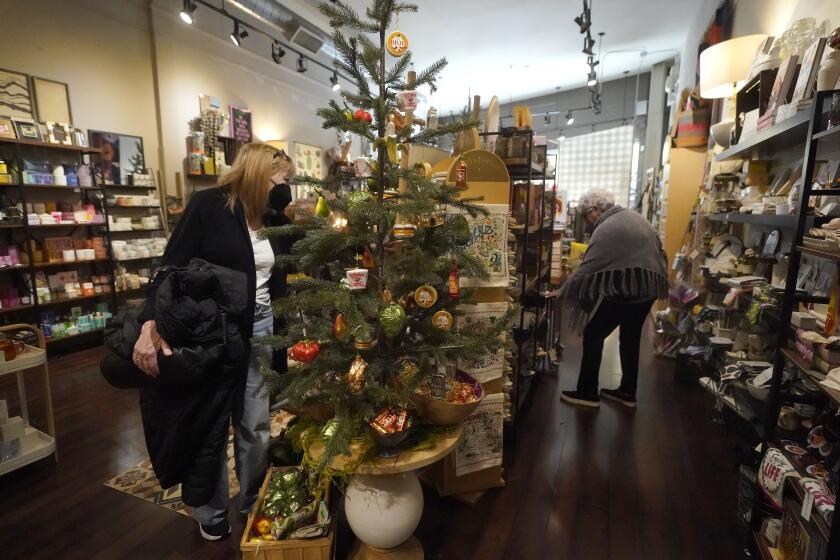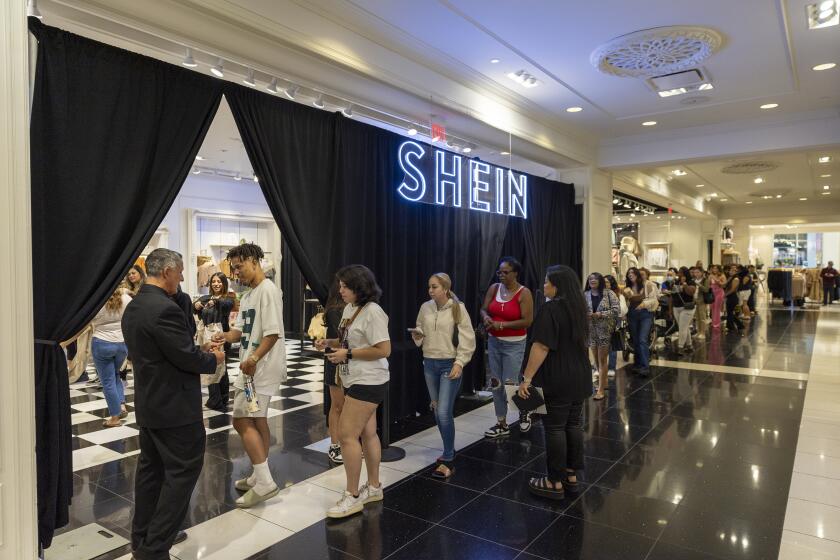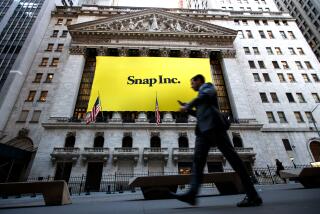Jess Hutchison / Los Angeles Times
- Share via
Want to know how much your friends are worth? Meet Flip, the shopping app that will put a price tag on every single person in your phone’s contact list.
Cajole one of them into signing up for the app, and you get cash — up to $130 per person — to spend on Flip.
“The crazy thing is people are worth different amounts of money if you successfully get them on the app,” said Lily Goldfarb, 27, a Flip user from Silver Lake. “I had one friend who was only worth, like, $25. It was really so sad.”
In some circles, this referral challenge has created a frenzied bounty hunt for one’s most valuable friends. And it has earned Flip a moment of buzz, a valuable currency in the competitive landscape of social shopping. Some estimates put the app’s total downloads at around 2 million.
El Segundo-based Flip, which sells an array of products from hip direct-to-consumer brands to snack foods, is pitching itself as a rare marketplace where customers can trust product reviews, and it’s willing to pay big bucks in user acquisition costs to get this vision up and running.
Consumers’ resilience in the face of high inflation is expected to continue through the holiday season with retail sales expected to top a $957 billion, a record amount.
The referral game is only one way the app compensates users. Flip, which officially launched some six months ago, will pay you for commenting on video product reviews and even just passively swiping through the app’s TikTok-style feed of seemingly endless content. If you review a product, you get a cut of the app’s ad revenue — no matter if the review is positive or negative.
Is Flip offering something that’s too good to last? Probably. Enabling consumerism on a whole new scale? Likely. And yet — it might be better than the status quo.
At the very least, Flip is aiming to respond to the ills of today’s online shopping landscape: fake reviews, discrepancies between product photos and what arrives on your doorstep, and influencers endorsing mediocre products with unwarranted enthusiasm. The company is promising another way to shop, one where the consumer should feel like the winner.
The bounty hunt
It’s easy to be swept up in the cash grab of Flip’s referral game. Each user’s potential earnings are shown in a thermometer-style graphic on the app: names of your phone contacts are shown next to their “worth,” and the total value of your possible winnings is front and center. For many users, this number is tens of thousands of dollars.
Goldfarb, who works at a nonprofit, was initially wary when a friend sent her a $75 referral coupon to join Flip, but it was hard to say no to, as she called it, “free money.”
Upon seeing the $75 in her account, the former skeptic was transformed. Goldfarb quickly became one of the most avid Flip users among her friends. In November, she earned nearly $850 from referring 14 people to the app, including her mom. She spent the cash on skin care, hair products and kitchen supplies.
E-commerce giant Shein hosts its first bricks-and-mortar pop-up in a surprising spot: a Southern California mall inside the shop of one of its biggest rivals.
Flip’s founder keeps close to the vest how the company determines the value of your friends, but many have noticed that Flip syncs with a user’s phone contacts, and those with more friends already on Flip command higher referral bonuses.
Lena Renshaw, 25, a software engineer and business school student who lives in Brooklyn, has earned close to $1,000 in referral bounties. The most she earned from one referral was $100. “It was definitely my most popular, cool friend,” she said.
But the most valuable contact Renshaw saw was a surprising one: her driver’s ed teacher from high school. “She had all of these students’ numbers saved throughout the history of time, which I thought was funny,” Renshaw said.
She used her winnings to outfit her kitchen with products from Flip — plates, cups, silverware, a lemon squeezer and Tupperware. She also bought books and a projector that makes her room look like a planetarium.
Come for the cash, stay for the anti-influencer reviews
“The whole concept of Flip is, how do we build honesty around commerce?” said Noor Agha, the app’s co-founder.
For starters, the company eliminated five-star product rankings, which are increasingly easy to fake on the internet. Instead, users flick through review videos before adding an item to their cart, using the same addictive thumb scroll as TikTok and Instagram Reels.
Unlike TikTok and Reels, product reviews on Flip are mostly made by everyday people, not professional influencers being paid thousands. Brands are banned from sponsoring video reviews. And everyone engaging in the process — from creators to viewers to commenters — can make a few bucks along the way.
“Who do you trust more: Flip or the brand? Or the person that bought it before you?” Agha said.
Flip assumes that when you incentivize everyone to give the pros and cons in their own product testimonials in exchange for a little cash, you’ll get an honest space online.
“If everything is positive,” Agha said, “it means everything is a lie.”
The company is betting this value proposition will set it apart from rivals, like TikTok Shop, which already has a built-in audience; TikTok has 150 million U.S. users, and teens spend an average of nearly two hours a day using the app. TikTok Shop is teeming with product-pitching influencers, many of whom have discovered they can earn enough commissions to make reviews a serious side gig.
Ever since TikTok launched its in-app shopping feature, creators have flooded the platform with product testimonials. Why are they so dang convincing?
Flip reviewers automatically earn money, with the amount varying based on the engagement a video gets. Brands cannot pay creators to make content, and the app pays all creators the same rates, regardless of follower count. These earnings are a cut of Flip’s advertising revenue, although the company is not yet profitable. (“It’s still early days,” Agha said, adding that Flip has roughly 150 advertisers so far.)
“I saw a lot of people making video reviews for products they had gotten being like, ‘this is terrible,’” Renshaw said. “I thought that was unique about the app and something that you wouldn’t find on Instagram.”
This is a new phase in the influencer ecosystem, said Blake Michael, a partner at CreatorLed Ventures, a venture firm for influencers. The first phase was the original mommy bloggers — genuine people who accidentally blew up online. The second phase was professional creators — those who set out to make a living shilling products.
“I think today we’re seeing the third step. … People are a little bit more skeptical to trust these people who are just famous for being famous, and they would much rather just hear from a real, normal person,” he said.
Earnings for creators on Flip can vary. One user posted a video review that attracted about 5,000 unique views and seven comments, earning her $31 in three days. Another earned far less — $13 in a month from three video reviews that attracted almost 4,000 cumulative views. Agha claims some super users earn between $5,000 and $10,000 a month. That cash either can be applied to in-app purchases or directly deposited into one’s bank account.
Users can also accrue small amounts for watching, liking and commenting on videos, a few cents per action. That revenue can only be credited to in-app orders.
Any stigma of buying fashion secondhand is gone. Shoppers are running mini resale businesses as the investment value of certain luxury brands has soared.
The real question is whether all of this cash really does buy legitimacy for a new marketplace up against sizable competitors. Not everyone is sold.
“It was really hard to gain people’s trust with it,” said Uma Bates, 28, a copywriter and fiction writer who lives in New York. “I think that convincing them that [the app] was legitimate and that their information wasn’t going to be stolen was an incredibly hard thing to do, and I can’t say that I convinced many people to use it, just a few here and there.”
Fuzzy economics, big competition
Flip is funding this endeavor so far with $95 million in venture capital backing. The company closed a $60-million Series B funding round last summer led by WestCap, according to a company press release. Mubadala Capital and Streamlined Ventures also participated in the funding round.
Flip said it is currently focused on expanding its product offerings. “I promise you between now and the next three months, you will start seeing everything,” Agha said. “And by June, there shouldn’t be anything that you want to buy that you can’t find on Flip.”
The task is made easier by the company’s main distribution model: dropshipping. Brands handle their own shipping, and Flip handles the less capital-intensive business of customer service and returns. (The company will manage some brands’ shipping for an extra fee, but fewer than 5% have chosen that option.)
Even though Flip seems flush with cash, the start-up’s costly user acquisition strategy — and gamified sign-up process — is worrying some in the VC space.
“I just don’t know how long that’s going to last, especially if their product market fit revolves around people basically getting paid to use the app,” Michael said. Larger rivals TikTok Shop, Amazon Inspire and Instagram Reels all have a massive head start in the social shopping space. Michael also wonders how many users will be willing to transition away from using their referral bounties to using their own money.
Agha dismisses the skepticism. “Our job is to add the products, deliver the best e-commerce service, and people [will] talk to each other,” Agha said. “Whether it’s positive or negative, you get paid.”
Uncertainty about its future aside, this much is true: Flip is offering something hard to come by these days in the noisy and often dystopian world of social media — fun.
“I noticed that whenever I would invite somebody who had a much higher bounty, I would not be the first to be texting them,” Michael said. “[They’d] be like, ‘Blake, 20 other people have texted me about this,’” he said.
The bounty hunt continues.
More to Read
Inside the business of entertainment
The Wide Shot brings you news, analysis and insights on everything from streaming wars to production — and what it all means for the future.
You may occasionally receive promotional content from the Los Angeles Times.















